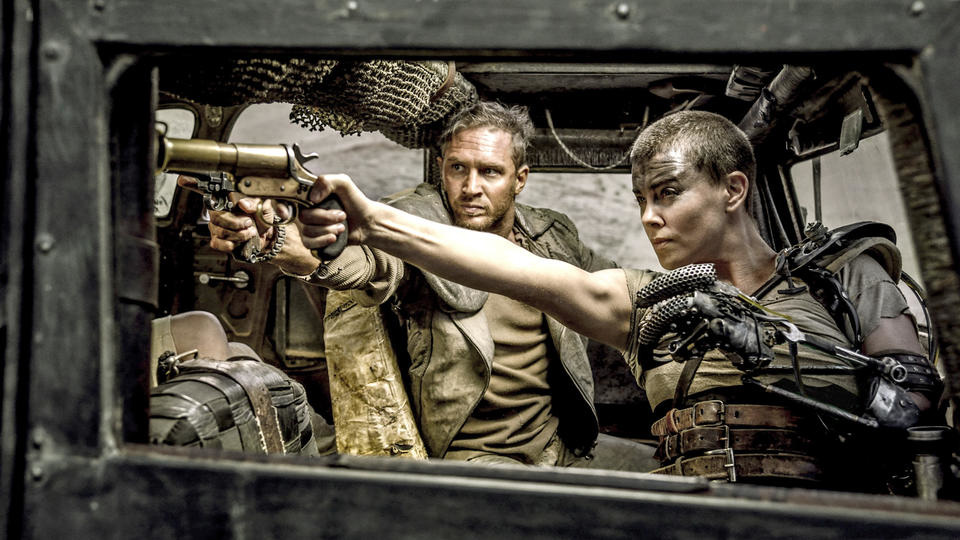Written by Megan Hess
When people called Mad Max: Fury Road (Miller, 2015) “explosive,” they weren’t just referring to the film’s literal explosions.
While Mad Max: Fury Road, the latest installment in the Mad Max franchise, has the same, if not similar, look as its predecessors, it achieved a different feel by tweaking the rules financially successful action movies traditionally follow.
For one, George Miller relegated his titular character to sidekick status. Max Rockatansky (Tom Hardy) still gets his name on the marquee, but it’s not his movie this time around. Instead, Imperator Furiosa (Charlize Theron) drives (literally) most of the film. Along with downstaging Max, Mad Max: Fury Road has a more nuanced plot and deeper, more resonant themes than its cohorts. Its central plotline - in a post-apocalyptic society, a disabled woman rescues other women from sex slavery - provokes discussions about autonomy and empowerment. Many call it a “feminist” movie. But, despite assuming the feminist label himself - “I’ve gone from being very male dominant to being surrounded by magnificent women. I can’t help but be a feminist” (Rich) - Miller has not been so direct about whether Mad Max:Fury Road is or is not a ‘feminist’ film. “Initially,” (italics mine), he said at a Cannes press conference in 2015 “there wasn’t a feminist agenda.” (Pantozzi). This vague statement only leaves things more open.
Miller hasn’t taken a stance, but his colleague, prominent feminist icon Eve Ensler, has. Best known for writing the play The Vagina Monologues, Ensler has written about and worked to prevent violence against women for years through her “global activist movement” V-Day (Ensler). Miller had her consult on the film in order to ensure an accurate depiction of the hardships his female characters faced. During an interview with TIME magazine, Ensler stated, “I think George Miller is a feminist, and he made a feminist action film” (Dockterman).
When viewing Mad Max: Fury Road through a feminist lens, it becomes a simple feminist allegory cloaked in jarring detonations: women push back against the status quo engineered to keep them down, and the patriarcy makes an attempt to “right” the disrupted world order. Mad Max: Fury Road fits not only the traditional definition of feminism - political, social, and economic equality for both sexes - but also the definition of intersectional feminism. While the second-wave feminism, which kickstarted the modern feminist movement, catered mostly to white, middle-class, heterosexual, American, women, intersectional feminism concerns itself with women of all countries, classes, races, and sexualities. It also seeks to get male participation in feminist efforts.
Mad Max: Fury Road shows intersectional feminism at work. By enslaving his young, beautiful, wives, Immortan Joe (Hugh Keays-Byrne) keeps them second-class citizens, canceling out the health, youth, and beauty they possess - traits that would give them power and status were they allowed to mingle with society. When Furiosa frees them, they’re grateful to have someone who treats them as people, not possessions - as Riley Keogh’s character, Capable, says, “We are not things!” - and follow her willingly, despite her missing limb. The wives react similarly when they meet the surviving members of Furiosa’s clan. Instead of seeing the women as less capable due to their advanced ages, they recognize how their wealth of experience can benefit their cause.
Feminist or not, Mad Max: Fury Road displays the simplicity of intersectional feminism. Men and women putting aside their differences to work together for the betterment of all involved, which doesn’t seem surprising or revolutionary - nor should it. In Mad Max: Fury Road, Miller suggests if the characters can accomplish this feat in their post-apocalyptic environment while pursued by an army of diseased men loyal to a dying tyrant, then the film’s audiences can also apply intersectional feminist principles to their (considerably more mundane) lives.
Works Cited
Dockterman, Eliana “Vagina Monologues Writer Eve Ensler : How Mad Max: Fury Road Became a Feminist Action Film.” TIME. TIME, INC. 7 May 2015. Web. 18 Dec. 2015 http://time.com/3850323/mad-max-fury-road-eve-ensler-feminist/
Ensler, Eve. “About Eve.” n.p. n.d. Web. 4 Jan 2015. http://www.eveensler.org/about-eve/
Pantozzi, Jill. “Mad Max: Fury Road’s George Miller: “Initially, There Wasn’t a Feminist Agenda.” The Mary Sue. Abrams Media. 15 May 2015.
http://www.themarysue.com/mad-max-fury-road-feminist-agenda/
Rich, Katey. Mad Max: Fury Road Director George Miller: “I Can’t Help but Be a Feminist.” Vanity Fair. Condè Nast. 14 May 2015. Web. 20 December 2015. http://www.vanityfair.com/hollywood/2015/05/mad-max-fury-road-george-miller-interview



 RSS Feed
RSS Feed
